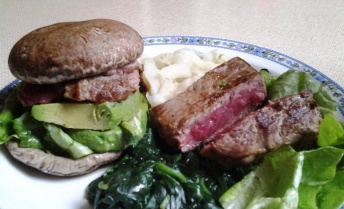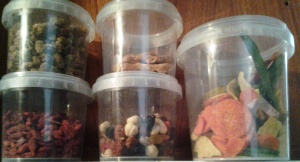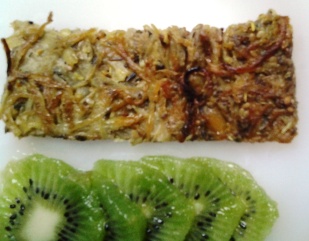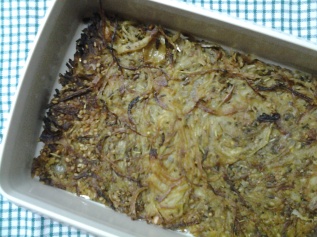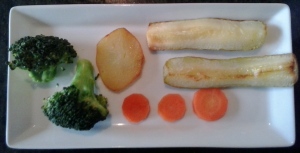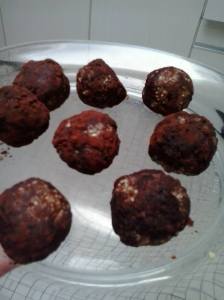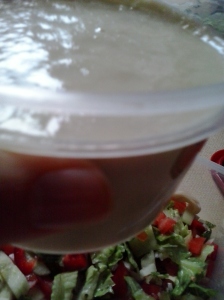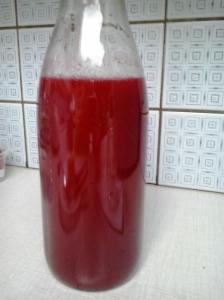I kinda missed the burgerfeeling. So I used two steamed portobello’s and layered lettuce, avocado and pieces of steak inbetween them. Then I grabbed the burger with both hands and took big bites of diliciousness!!
With the left over steak, I ate steamed spinach and steamed strings (I used a peeler) of parsnip.
MMMMmmmmm
Month: March 2015
Yeeeey <3 Le Panier du soleil!
I really wanted dried fruit today so I planned on going to a Nature shop.
I had to wait for the bus near the shopping center. So I couldn’t resist the temptation to enter the shopping center and maybe buy some clothes. But! Lucky me! Le Panier du Soleil has a temporary POS in the shopping center.
Time saved , and money spent on mullberries, goji berries, dried pineapple, mix of dried berries and nuts and freez-dried vegetables! 😀 yummie
Onion-nuts-herbs biscuit
Taste explosion allert!
Eases hunger very well.
This snack is made from
-Onion (2 large onions)
-pine nuts (approx 40 gram)
-sesame seed (approx 40 gram
-herbs (botanico mix)
-coconut oil
At first slice the onions with a mandoline and blend the pine nuts in a blender.
Mix the onions, pine nuts and sesame seed in a large bowl and add the herbs.
I used the ORAC botanico-mix from AMAN PRANA. (super food. www. noble-house.tk)
(sage, oregano, rosemary, thyme, szechuan pepper, turmeric, sumac, clove, cinnamon, vanilla, mustard seed, sweet pepper, coriande seed, lavender, …) But you can use whatever spice mix you like.
Warm some coconut oil in the microwave and pour it over the onion-sesame-pine nuts- herbs mixture.
Spread out the mixture on a plate with aluminium foil and put it in a preheated oven or use a dehydrator.
To flip, I place a tray on top, flip, and let it float back in the oven.
You’ll see when it’s starting to get brown and dry enough.
Then let the biscuit cool down on a new aluminium foil and conserve in the fridge.
The next morning your onion cake will have a nice texture.
I like to tear pieces of it whenever I feel the need for a small craving.
It helps me to avoid this kind of situations :
Enjoy!
xxx
Side dish – broccoli , carrot, zucchini, potato
What to eat on the Paleo Diet
What’s In:
- Meat and poultry (including offal) – grass-fed, free range meat is not only a kinder and more ethical way to consume animal products but it is also much higher in nutrients because of the way the cattle was fed and raised.
- Fish and seafood – try to choose sustainable, wild fish and seafood when possible
- Eggs – free-range, pasture raised whenever possible
- Vegetables – non-starchy and starchy tubers and root vegetables
- Fruit and berries – stick to low sugar fruit and berries and keep high sugar fruit like bananas and mangos for days when you need a higher carbohydrate intake or when in season and tasting delicious.
- Nuts and seeds – these guys are nutritious but many nuts and seeds are high in Omega-6 fatty acids which can be pro-inflammatory if consumed in large quantities and when your diet is not balanced by an equal amount of Omega-3 fatty acids found in oily fish like salmon and sardines, eggs and leafy greens. Basically, don’t gorge on buckets of nuts and seeds every day. The same goes for nut meals and flours such as almond meal. Whenever possible, try to activate nuts and seeds by soaking and then dehydrating them back, which makes them easier to digest.
- Spices and herbs – go to town, the more the better! As for salt, use good quality sea salt or Celtic salt to get beneficial minerals and be sensible with it.
- Healthy fats – coconut oil, coconut milk and cream, ghee, butter (yep, it’s mostly fat so no big problems with lactose), duck fat, olive oil, avocado oil, macadamia nut oil, fish oil, sesame oil as well as from grass-fed meats, poultry and fish.
- Condiments – mustard, fish good, quality vinegars such as Apple Cider with mother in it or aged Balsamic, olive oil mayonnaise, low sugar tomato sauces and paste, anchovies, olives, gherkins, capers, salsas and pestos – are all fine, just make sure no nasty chemicals and preservatives are added. Wheat free soy sauce such as Tamari and naturally derived oyster sauce are ok every now and again but it’s better to try something like coconut aminos.
- For baking – nut meals, coconut flour, tapioca and arrowroot flour, sweet potato flour, chestnut flour – use in moderation as these guys are either still high in carbohydrates or may contain high amounts of Omega-6 fatty acids.
(I also try to avoid eggs cause of my food intollerance)
Out
- Grains – especially wheat and anything with gluten. White rice is the least harmful of all grains and is added to dishes on occasions or for variety, it’s also part of the Perfect Health Diet protocol, which is what I follow. Rice is very high in carbohydrates and if you’re not active or trying to lose weight, it should be kept to ‘occasional’ use.
- Legumes – beans, lentils, chickpeas and so on. Cashews are not legumes! There are some debates over whether some legumes are safe to consume in moderation, if prepared properly (soaked for 12 hours and then cooked really well to remove the phytic acid and make them easier to digest). You can read this article by Dr. Chris Kresser and this article by Dr. Loren Cordain and make up your own mind like we do. We include green beans and peas but avoid the rest.
- Refined sugars and carbohydrates – bread, pasta, cookies, white sugar, artificial sugar, high fructose syrup, sodas, fruit juices and so on.
- Dairy – especially milk and low fat dairy, and for those with damaged gut or gluten/lactose intolerances.
- Processed vegetable oils and fats such as canola oil (rapeseed), soybean oil, vegetable (Is it really made from vegetables? We don’t think so), and sunflower oils, as well as margarines and spreads made with such oils.
- Gluten containing products
Ok, on occasion:
- Dairy should mainly be avoided, especially if you suffer from gut problems and gluten intolerances, but if you’re in good health and have no sensitivities to lactose (sugars in milk) or casein (protein in milk) then a little healthy dairy can go a long way. Avoid cow’s milk as it has a high Glycemic Index unlike cheese or yogurt. Better options are goat’s and sheep’s milk products, A2 cow’s milk and cow’s milk fermented products like kefir, unsweetened yogurt, aged cheeses, full fat cream, butter, and ricotta.
- Natural sweeteners – honey, maple syrup, molasses, dried fruit, dark chocolate, palm sugar, rice malt syrup for those avoiding fructose.
- Alcohol – dry wines, clean non-grain based spirits.
- Fermented soy such miso, tempeh in small amounts, wheat free soy sauce
- Pseudograins like quinoa, amaranth and buckwheat are less harmful but they are still dense sources of carbohydrates and contain similar antinutrients to grains. They should be prepared carefully to remove some of the anti-nutrients such as phytic acid. Soak such grains in salted water for 8-12 hours, rinse and then cook well before consuming. Chia seeds also fall in this category. Buckwheat is the safest out of these.
- Fresh corn, green beans and green peas fall into grain/legume category but in our eyes they are totally fine to use every now and then and especially when in season and local.
Date – pecan – cacao balls
-dates, Medjool
-pecans
-raw pure cacao powder
Split one side of each Medjool date lengthwise and remove the pit.
Cut the dates in small pieces and put them in a blender.
For 100 grams of dates ad 30 grams of pecans.
Blend blend blend!
Aterwards you can take small portions of this sticky mass and form little balls.
Eventually you may want to roll them in cacao powder.
De Li Cious !! 🙂
